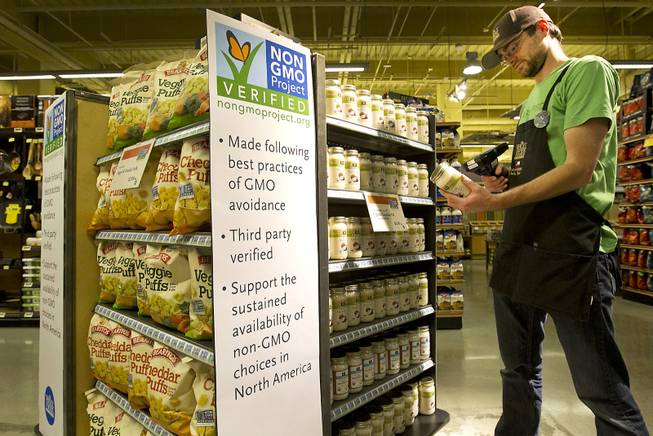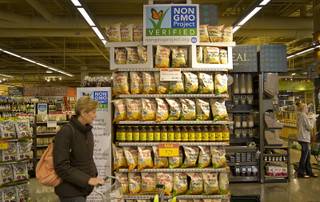
Ralph Barrera/Austin American-Statesman / MCT
Whole Foods Market believes consumers have the right to know how their food is produced and this includes whether or not it contains Genetically Modified Organisms or GMOs. Here, store employee Ian Purdue scans non-GMO products for ordering at the 6th St. and Lamar downtown store in Austin, Texas, April 10, 2013.
Thursday, April 18, 2013 | 2:33 p.m.
In the past few years, Whole Foods Market has gotten much stricter about where its products come from.
The natural foods grocer has rolled out a series of standards regarding animal welfare, seafood sustainability and genetically modified ingredients — to name a few — that is unprecedented in scope for a major food retailer.
Whole Foods officials say they’re staying true to their core values while also reacting to changing times and concerns from their customers.
“I would represent these latest efforts as a further step in a direction we’ve been pursuing for 32 years, which is to provide some sort of clarity, some sort of definition, some sort of leadership in the marketplace,” co-CEO Walter Robb said.
And although it’s impossible to predict the future, given Whole Foods’ prominence, it could affect the larger grocery industry, as well.
Although most supermarket chains have their own sets of standards, Whole Foods’ appear to be the most stringent in the industry, analysts say.
“They’ve definitely taken it to a whole different level,” said Brian Yarbrough, an analyst for Edward Jones.
Since 2010, Whole Foods has unveiled the following standards:
• A color-coded rating program that measures the environmental impact of its wild-caught seafood. A green rating indicates the species is relatively abundant and is caught in environmentally friendly ways. The worst, a red rating, means the species is overfished, or that the methods used to catch it harm other marine life or habitats. Red-rated species were eventually phased out by Whole Foods.
• An animal welfare rating system for meats and other livestock products. The five-step rating system starts at step 1 (animals aren’t crowded or kept in cages or crates) and goes to the highest tier, where animals spend their entire lives on the same farm.
• A rating system for household cleaning products, based on the environmental-friendliness of ingredients. Red-rated products do not meet the standard and aren’t sold at Whole Foods. Products can’t receive an orange rating if they’ve been tested on animals or have artificial colors. The highest rating, green, is given to products with all natural ingredients and “no petroleum-derived ingredients.”
• And this year, the company announced that all products in its North American stores that contain genetically modified ingredients will be labeled as such by 2018.
Robb said the reasons for the new standards have been varied.
For instance, the meat standards came about partly because Whole Foods founder John Mackey was influenced by various books on animal welfare. Also, the label of “natural meat” was meaning less and less in the industry, Robb said.
As for seafood, the program was a reaction to concerns about overfishing and the environmental effects of certain fishing methods.
Other standards, such as the ones on household cleaning products, were partly for competitive reasons — Robb said Whole Foods didn’t have a “very good offer” in those areas.
As for genetically modified ingredients, Whole Foods first endorsed them for labeling in 1992, Robb said. But it never got much traction until a new process for modifying alfalfa, which is used to feed livestock, popped up in the news. And a proposition in California to label genetically modified ingredients in products last year — while it ultimately failed — further brought it into the public consciousness.
“It’s up on the table now and people are talking about it,” Robb said. “It’s part of the national conversation.”
But Whole Foods isn’t reacting to market forces as much as it’s staying true to its core values of providing high-quality foods, he said.
“From the beginning of the company, the core value No. 1 is selling the highest-quality natural and organic foods,” he said. “So in a way, the company is built on a standard. And that standard ultimately is the thing that sets Whole Foods apart.”
Andrew Wolf, an analyst with BB&T Capital Markets, said the new standards, especially regarding seafood sustainability and labeling products with genetically modified ingredients, represent Whole Foods getting into the “bleeding edge” of food standards.
But it’s consistent with Whole Foods being a mission-driven company of “leading the consumer toward more healthy eating and living,” he said.
“It’s just consistent with who they are, is the simplest way to put it,” Wolf said.
Yarbrough said the new standards are an evolution of the natural and organics industry that Whole Foods has built.
“It’s just another way of building customer loyalty and building that faith in that, when they offer something, they’re serious about this business,” he said. “And these are ways just for them to say, ‘Hey, we’re really serious about it.’”
Yarbrough said he doesn’t see the standards being widely emulated by other chains, particularly larger ones with limited organic offerings.
There is some evidence that isolated chains have followed suit in some areas, particularly in seafood sustainability, he said. But on the whole, Whole Foods stands alone, he said.
Wolf said labeling genetically modified ingredients could trickle down to more traditional retailers — pointing to gluten-free products and natural foods in general as examples.
And larger chains such as Safeway and Kroger are now talking about animal welfare and seafood sustainability, he said.
Whole Foods’ vow to label all genetically modified ingredients has pushed the issue to the forefront of the industry and could influence other retailers, according to trade publication Supermarket News.
The question figured prominently last month at a panel discussion at the natural products expo, Expo West.
Mary Mulry, who formerly headed up natural foods for H-E-B and is now president of FoodWise, a consulting firm, said that consumer demand changes much quicker than the industry.
“To walk back the food system is going to take a minimum of five years because of this process of change,” she said. “Awareness until now has been minimal, and now everyone wants non-GMO. The food supply needs time to catch up to that.”
Gary Hirshberg, chairman of both Stonyfield Yogurt and the Just Label It campaign whose objective is mandated labeling of GMO foods in the U.S., also favored the move.
“From a sheer competitive point of view, it’s a brilliant move because for so many retailers who are trying to compete with (Whole Foods), it says, ‘You’re going to have to do this, too, if you want to offer a parity proposition,’” Hirshberg said.
Asked if he hopes to have a larger impact on the industry, Robb said he thinks customers would be best served “by having a uniform set of standards.”
“So yes, I do think we would hope that this would result in that ultimately happening,” he said. “I think that’s easiest for the customers, easiest for the suppliers, easiest for the marketplace to digest.”
Robb also said that over time, things generally become more transparent — especially as more information becomes available thanks to technology.
“In many cases, the customers are leading these efforts now,” he said. “They’re asking questions, they’re more well informed, they want to know where their food is coming from, they want to know how their food is produced and they want to know what you’re doing about it. ... Particularly for us, I think we’ve made our name on this, so maybe their expectations are higher of us than they are of other grocers. That’s fine.”


Join the Discussion:
Check this out for a full explanation of our conversion to the LiveFyre commenting system and instructions on how to sign up for an account.
Full comments policy